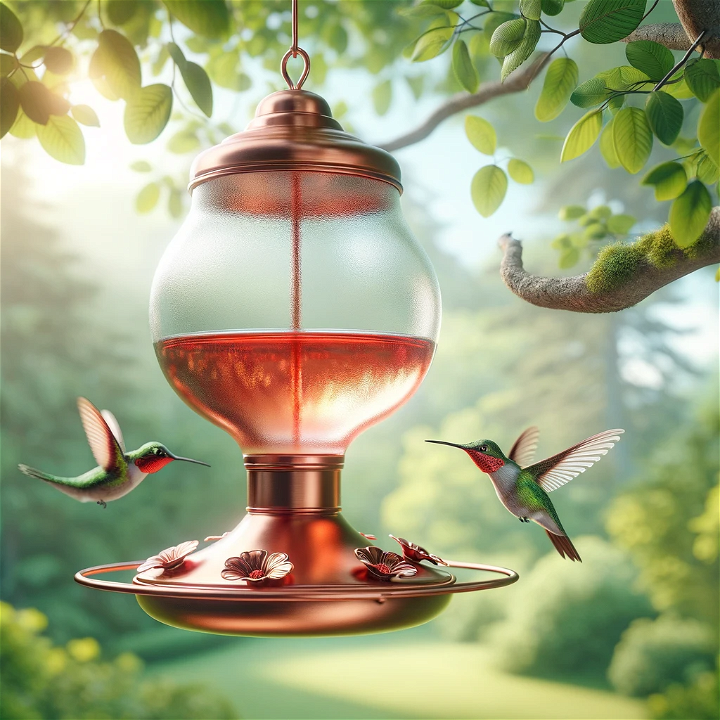Hummingbird feeders are more than just a charming addition to your patio. They are a beacon of hope, a symbol of hospitality, and a testament to the beauty of nature. These feeders, meticulously designed to attract the fluttering jewels of the sky, serve as a bridge between us and the enchanting world of hummingbirds. Each feeder, whether it’s made of glass, plastic, or metal, is a testament to our desire to connect with nature in our own backyards. But remember, these feeders are not just about aesthetics; they require a commitment to regular maintenance and a love for our feathered friends. So, as you hang a hummingbird feeder, you’re not just adding a pretty accessory to your patio, you’re opening a window to a world of wonder, right in your own backyard. Let’s embark on this journey together, welcoming these tiny marvels into our lives, one feeder at a time.

Understanding Hummingbird Feeders
What is a Hummingbird Feeder?
A hummingbird feeder is a specially designed device that attracts hummingbirds by offering them a substitute for nectar, their primary food source. These feeders are typically filled with a sugar solution, which provides the birds with the necessary energy for their high-speed lives. They come in various shapes and sizes, often adorned with bright colors to attract these vibrant creatures. The feeder’s design usually includes multiple feeding ports, mimicking the multiple flowers a hummingbird would visit in the wild.
Why Hummingbird Feeders are More Than Just Decorations
While hummingbird feeders add a touch of charm to any outdoor space, their purpose extends beyond aesthetics. They serve as a crucial food source for hummingbirds, particularly during migration periods when natural nectar sources may be scarce. By installing a hummingbird feeder, you’re not just enhancing your patio’s appeal; you’re contributing to the conservation of these remarkable birds. These feeders also provide an opportunity for birdwatchers and nature lovers to observe hummingbirds up close, learn about their behaviors, and appreciate their beauty.
Starting Your Journey with Hummingbird Feeders
Choosing Your First Hummingbird Feeder
Selecting your first hummingbird feeder can be an exciting task. Consider factors such as the feeder’s capacity, the number of feeding ports, and its resistance to pests. A feeder with an ant moat and bee guards can be particularly beneficial. The color red is known to attract hummingbirds, so a red feeder can be a good choice. Also, consider the material of the feeder. Glass feeders are durable and often more attractive to hummingbirds than plastic ones. However, they can be heavier and more fragile.
Once you’ve considered all these factors, you can shop online for a variety of hummingbird feeders that suit your needs and preferences.
Where and How to Install Your Hummingbird Feeder
The location of your hummingbird feeder can significantly impact its success. Choose a quiet, shady spot that’s safe from predators. Hanging it near a window allows for easy viewing, but ensure it’s secure to prevent swinging or falling. Remember, patience is key. It may take some time for hummingbirds to discover your feeder. Also, consider the height of the feeder. It should be high enough to deter pests but low enough for you to clean and refill easily.
Essential Knowledge for Hummingbird Feeder Enthusiasts

The Science Behind Attracting Hummingbirds
Hummingbirds are attracted to cheerful and bright colors, especially red, which they associate with flowers rich in nectar. The sugar solution in your feeder mimics this natural nectar. Regularly changing the solution and keeping the feeder clean will ensure your feathered visitors keep coming back for more. It’s also important to note that hummingbirds have excellent memories and will remember the location of your feeder, returning to it season after season.
Maintaining and Cleaning Your Hummingbird Feeder
Maintaining your hummingbird feeder is crucial for the health of your visiting birds. Regular cleaning prevents the growth of mold and fermentation of the nectar. Rinse the feeder with hot water every few days and scrub it with a bottle brush. Avoid using soap as it can leave harmful residues. Also, ensure to refill the feeder regularly. A feeder that’s often empty won’t attract hummingbirds.
Advanced Tips for Hummingbird Feeders
Seasonal Tips for Maximizing Hummingbird Visits
Different seasons require different care for your feeder. In spring, put out your feeder early to attract migrating hummingbirds. In summer, change the nectar frequently due to heat. In the fall, leave the feeder out late to help stragglers on their journey south. These tips can help maximize your hummingbird visits. Also, consider planting native flowering plants in your garden. They can provide additional food sources for the hummingbirds and make your yard more attractive to them.
Troubleshooting Common Hummingbird Feeder Problems
If hummingbirds aren’t visiting your feeder, try moving it to a different location or adjusting the nectar concentration. If ants or bees are a problem, consider a feeder with built-in guards. Remember, attracting hummingbirds can take time and patience, so don’t be discouraged if they don’t show up immediately. Also, avoid placing your feeder too close to windows to prevent bird collisions.
Conclusion Hummingbird feeders are a delightful way to connect with nature and provide a helping hand to these extraordinary creatures. With the right knowledge and care, your feeder can become a bustling hub of activity, bringing endless joy and fascination. So, why wait? Start your hummingbird feeder journey today and witness the magic these tiny birds bring to your backyard. Happy birding!
